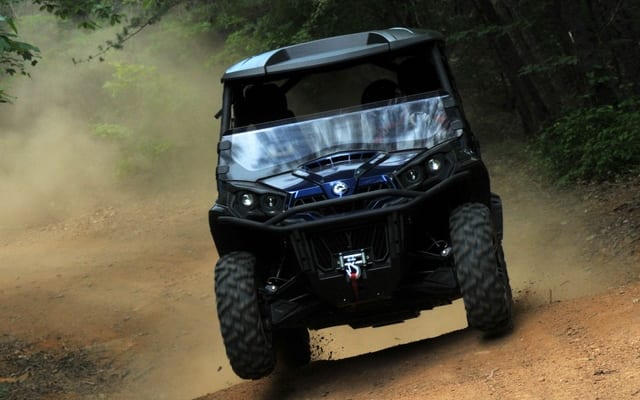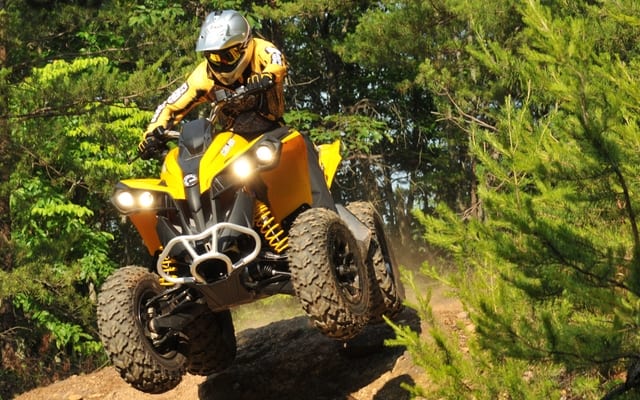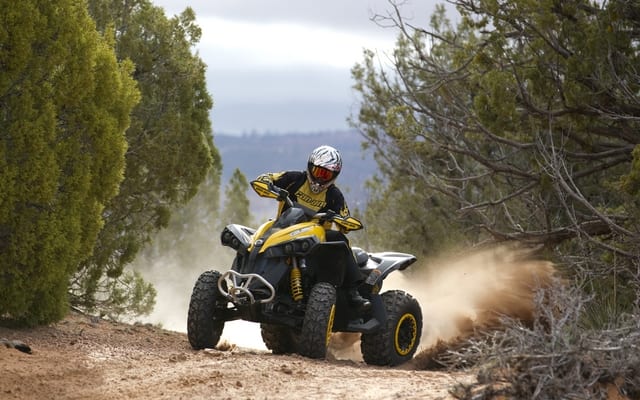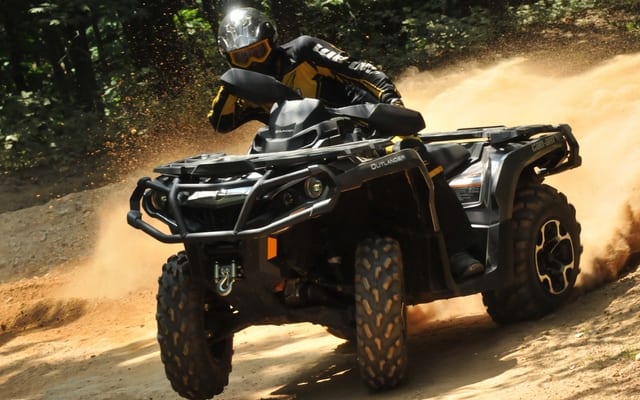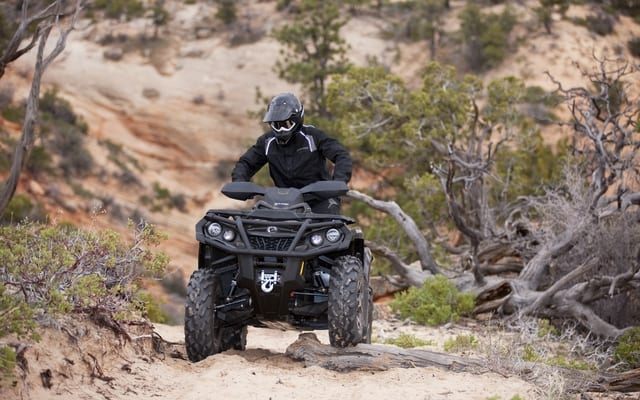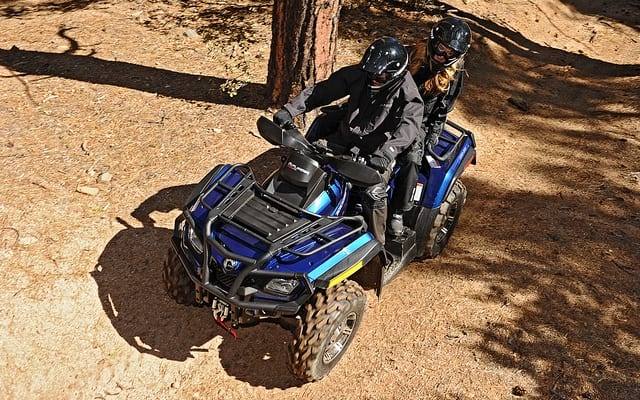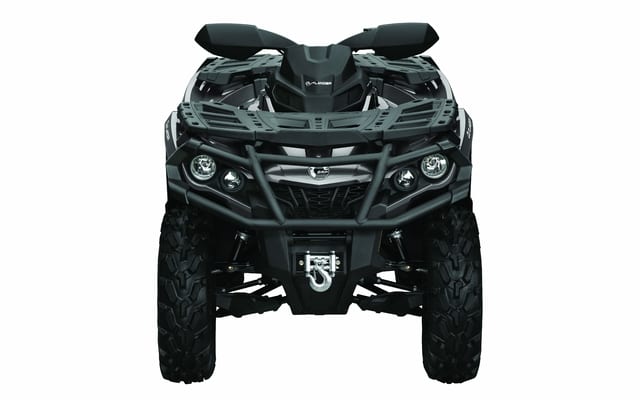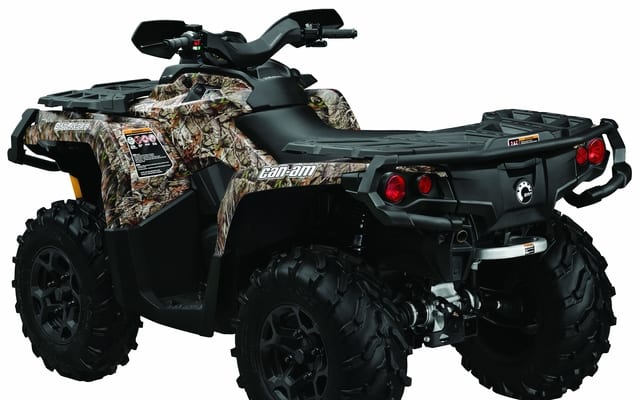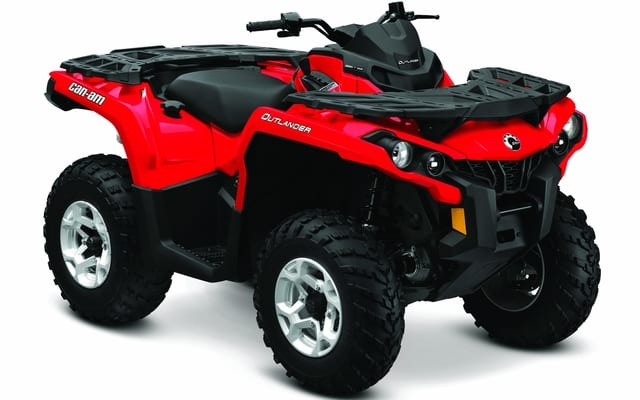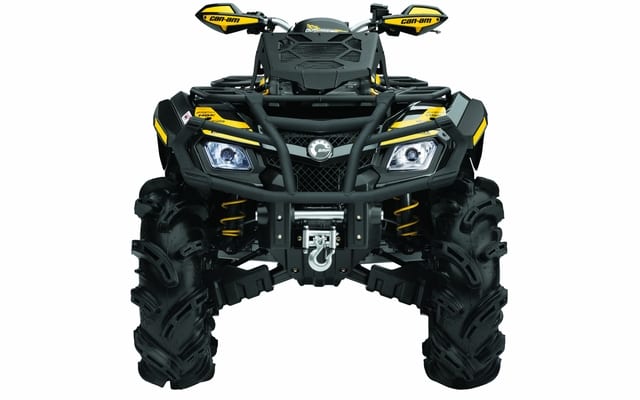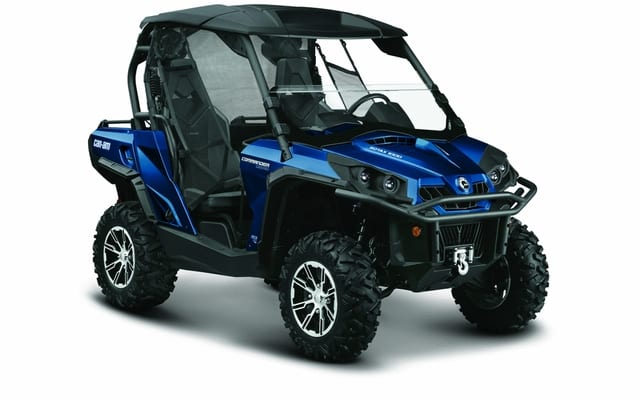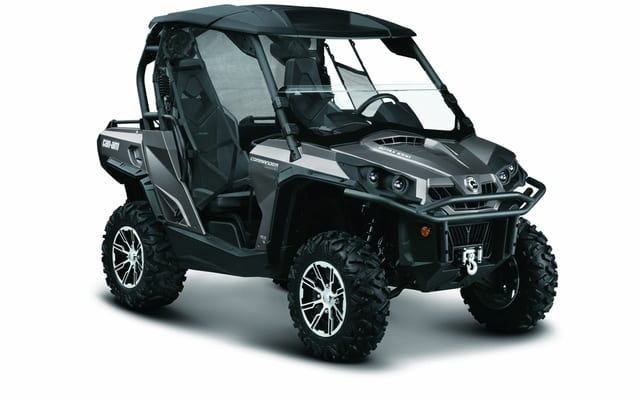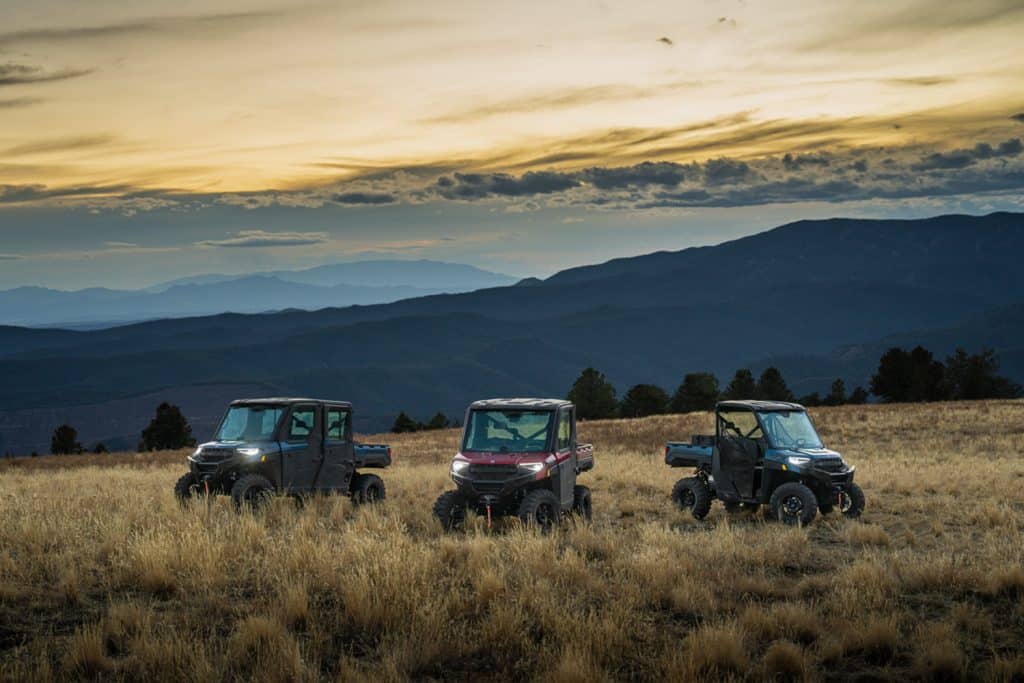Fun and excitement are more than ever part of the Can-Am mentality. Proof of that was hidden underneath various black covers, as ATV industry press members including myself were anxious to see those covers pulled off of four new offerings; the BRP people had proudly propped up high on a show stage.
Thank God for these guys! Without them, the ATV world would be a boring place, through these tough economic times. Surprisingly enough, between 2009 and 2010, BRP’s annual growth reached 26 %. About 1.7 million recreational units are sold annually around the world. ATVs account for 65% of them. Snowmobiles and personal watercraft represent 9% and 7% of the total. According to figures from the Ministry of Economic Development, Innovation and Export Trade, over 70% of their worldwide sales are made in the United States. Canada is the second biggest market for BRP. Europe, Australia, Russia and Brazil follow.
This success is quite encouraging and can be attributed to BRP’s talent in bringing forward exciting new vehicles. For 2011, the new line of Commander Side x Side vehicles stole the show and BRP has been struggling to keep up with high demand for these fun and highly versatile vehicles. This time around, new Can-Am quads are stealing most of the attention, as some of the new models put forward have the potential of bringing quad conception leaps forward, with intelligent innovations.
A new outlander
This was the last vehicle to be revealed during this classy presentation, but we need to get right to it here. It is, by far, the one that has gone through the most radical transformation, and I know I’m going to run out of space real fast in this article, which needs to cover the entire 2012 line of Can-Am products. So, many changes were brought to this popular model, or I should say: models? You can bet we will be asking for a unit, so we can focus exclusively on this part of the Can-Am family of quads in coming issues. We only spent a few hours on the new Outlanders at this launch, which were well enough to impress most attending, with what seems to be just the right set of improvements.
Most important to know for many, is the new 1000 choice of engine displacement, for both the Outlander and Renegade. Fitting the new Rotax 1000 V-twin, brought forward with the launch of their new Commander Side x Side, in an Outlander and/or Renegade, was a somewhat predictable move, yet surely not a simple one. The main factor permitting such boldness is a totally re-designed chassis called the SST G2, which stands for 2nd generation Single Spar Technology frame. Both the Outlander and Renegade models use this new frame now, which will hold up much better to torsional forces. This time around Can-Am engineers took an innovative approach in its design with state of the art Computer-aided Vehicle Dynamics (CAVD) software. This new concept in design principles is what BRP calls Geometric Contact Control. In other words, they are trying to maximize the contact of all four wheels with the terrain, using geometry alone to control certain unwanted behaviours.
This new welded-steel SST frame‘s updated geometry is said to increase structural integrity, improve durability and offer more precise handling. As far as the handling part is concerned, I totally concur. It truly felt easier and smoother to ride, in general than the 2011, which seems to need the X xc’s high-end suspension, to truly be able to harness all the power. This brings me to mention that is no Outlander 800R X xc in the 2012 line of Can-Am ATVs. That endurance racing inspired package is available only for the Renegade 800 or 1000 this time around. There is another new Outlander model that could tickle your fancy: the Outlander Max 650/800R XT-P, that offers cool add-ons like BRP’s innovative ACS (Air Control Suspension) with HPG FOX Racing Shox rear shocks, their quicker engaging Visco-Lok QE, Carlisle ACT tires mounted on 12 inch aluminum beadlock wheels; and their new Tri-mode DPS. This is not a typo; they’ve added a third mode to the Dynamic Power Steering system. I was glad to learn that the old “Min” mode has become the “Med” and that the added mode is one with even less assistance than the previous “Min”.
The 976cc, 80-degree V-Twin produces an industry-highest 82 horsepower. This certainly also means that throttle response is even more aggressive than it already was with the 800R, and now one needs to be very careful not to tap on the gas inadvertently through rough sections, as it can send you inspecting the sky in a jiffy! Trust me, even experienced riders, need to be warned.
A new air box is used on both the 800 and 1000 models, positioned higher and in a more centralized location. Its dual-chamber design improves air filtration, by capturing dirty air in one section of the air box and accumulating clean air in its second section, before it is drawn into the engine.
You must have noticed the big change in looks too. This aspect is, of course, much more personal, but I for one, think it totally rocks! I’m all for calm riding on an aggressive-looking ride. The most important fact to note is that this change is not merely the result of differently moulded plastics. Most of the visual changes are the result of things being more conveniently designed. The lighting for example, with a change to a four lights setup like the Renegade, more for improved performance than anything else, ends up radically changing the look, into one that works better at keeping all Can-Am rides tied together as a group, thus reinforcing the Can-Am DNA concept. The racks are also better, with integrated anti-slip pieces of rubber to help keep cargo securely fastened and more holes to hook up bungee cords. There are no apparent fasteners joining the plastic panels. This helps create a much cleaner look.
Ok, now I need to speed it up a bit. Something our friends at BRP seem to be fond of. The new Outlander has a re-located key, new digital gauge, the D.E.S.S. now comes standard with 2 keys; the black for full power and the grey, which limits speed to 44 mph. In addition, a larger radiator for increased cooling, a much larger water-resistant rear storage box (5.7 gallons) and new LinQ quick attach accessory system. Boy, let me catch my breath! We are far from being done!
Remember, we will try to come back with a more detailed article, solely on the Outlander in coming issues. For now, I at least, need to mention every new detail. Smaller changes, which are not even mentioned in any of the documentation handed to us. The shifter is shaped differently, better fitting with the machine’s edgier look, but more importantly, it doesn’t hook at all like the old one does, it is much smoother in operation. They added a tiny arm to the park brake, which makes it a breeze to click in with one hand. As usual, both the 800R and 1000 are available in Can-Am’s XT package that adds the new Tri-Mode Dynamic Power Steering (DPS), quicker-engaging version of the Visco-Lok front differential, a 3,000-pound Warn winch, cast aluminum wheels with custom finish, 26-inch Carlisle ACT radial tires, heavy-duty; front and rear bumpers, 650-watt magneto, handlebar wind deflectors, and optional painted plastic bodywork.
Other interesting improvements include new center-less wheels, which were designed with a new computer program that is able to maximize strength, while using a minimum amount of material. This means that the end look was almost completely dictated by the program. The result is both pretty and functional; since unsprung weight ends up being further reduced. I guess you will have to stay tuned for a lot more information on this total redesign of the Outlander. We haven’t talked about brakes, ergonomics, and the engine braking, which is much better now, and a whole bunch of other things.
A luxury commander
The BRP team sure has a knack for giving many off-roaders what they want, and make others wish they could have the same. The Commander certainly caught many people’s attention when coming out in 2010 (as a 2011 model). Even in its most basic form, it comes standard with a much more interesting number of convenient accessories and innovations than most Side x Side vehicles on the market today. Things like the dual-level rear cargo box, or safety features like the multiple key system to restrict the speed of the vehicle at different levels, as well as the solidly and very easily clamped in side-nets with belt buckle style anchoring, put the vehicle on many consumers’ wish list. Versatility is this vehicle’s best quality; it can truly be enjoyed as much at work than at play. Although it wasn’t what I was hoping for exactly (a full-on race ready Commander to blow the new Polaris RZR XP 900 into a dust cloud), I could understand why the Commander LTD was a more logical next step to take, for now.
I think there is more demand for added gadgets than there could be for extreme power and suspension. Ideally, they would have done both, but let’s give them a break, as you can see these people had enough on their plate for the 2012 model year. One encouraging comment from a BRP executive at this grand event was: “We are aiming to be on top of every vehicle class, in less than three years.”
The approach with this LTD model is quite simple: give them everything they could want, as standard equipment. For those who know they are going to pay for it all, anyway, and then need to pay again to have things installed or spend long hours in the garage, this all-included solution might be an interesting choice to consider! When I said everything, I wasn’t kidding! Ok, ready? It is time to take a deep breath for the next phrase to read. Starting with the usual: a two-piece full hard roof, half-windshield, rear wind screen, limited seat trim, 14-inch cast-aluminum wheels with limited finish, a sound system with four integrated speakers, and get this: iPod/iPhone connector with gauge controls, USB port and auxiliary input, … (take another deep breath here) even a Garmin Montana 650t GPS, which is tightly squeezed in rubber trim and easy to snap out, with USA and Canada topographic maps already loaded in, and also a 5 megapixel camera, and now ending this never-ending list of cool stuff, with all the XT package features. Aaah! Don’t tell me you don’t know what the XT add-ons are! Oh no! Here I go again.
The 4,000 lbs. Warn winch, the bed rails, mudguards…You know what? I can’t take this anymore! Please help me out and get on the BRP website to find out everything there is to know, as far as features are concerned. You know I did actually try this ride! I would love to have a chance to share that experience with you. Thing is, I actually left out the one most awesome and important feature exclusive to this new LTD stamped Commander. The ACS (Air Control Suspension), yet another great innovation from this band of sleep depraved adrenaline junkies, uses an inboard compressor, which also includes a hose to adjust tire pressure, to adjust the FOX Racing Shox HPG piggyback shocks on the fly, to a choice of six settings. You can adjust all four corners at a time or the front and back separately. The shocks are also adjustable manually independently from the gauge.
Wind blows by, but I don’t hear it.
I floor it out of a turn and I feel the growl of the engine through the seat more than I hear it. Born to be wild is blasting and I’m having the best time of my life! Power wise, I’ve been more than satisfied with that aspect since my first try at the commands of a Commander, even the 800. On the suspension side of things, I was also satisfied, but only to a certain degree. If I cruise around on fairly groomed trails, the Commander is an absolute joy to ride. If a trail gets really rough, I find I am forced to slow right down for it to stay enjoyable. Which might actually be a very good trait in some sense; the vehicle sort of bounces you around just enough so that one can get the giggles, before things actually get dangerous. Playing with the traction through the rough or deep stuff at a slower pace is really great fun, and that is what users should bank on with this cool-looking machine. I for one, tend to like trying to keep a good pace in those instances,, so my Commander LTD was exposed to some riding near the edge of its abilities, and stayed safe with a whole lot of fun throughout the entire intense part of my testing.
Playing around with the ACS settings, as I was cruising around on these amazingly beautiful North Carolina trails, I discovered a nicely placed range of adjustments. Meaning, I could truly feel an advantage in changing modes for different types of riding. Not being stuck to leave it at one or the other end of the spectrum, wishing I had more numbers to choose from. My curiosity had me dropping to the lowest setting when the going got rough and climbing it to the top when on flat trails again, to sort of getting a feel for how this affected the handling. I then tried the complete opposite, to discover that it doesn’t really matter, in a safety sense, what setting you do choose. Ideally, you would travel the rough sections slowly with the ACS at the highest setting to clear all the rocks, and get more feedback from each obstacle, but this does mean the occupants get shaken up more. If you are pushing the machine a little on flatter grounds, you are better off leaving it at that high setting for the best handling in turns possible.
I found the #3 setting to be perfect, when riding at a calm pace, through varied conditions. I didn’t really get the opportunity to play around with the Garmin GPS much, but I couldn’t help but think back at a time, not so long ago, when no trail rider could bring that much peace of mind along for the ride. Trail riding used to be an activity, which required a great deal of skill in not getting lost in the vastness of the wild. I can imagine it being a life saver in many situations, like being struck by a bad snow blizzard, in a remote location. To sum it all up, this whole experience thoroughly pleased me and left me wanting to ride this gem a whole lot more!
Oddly enough, despite this lengthy article, I feel many things about the 2012 Can-Am Off-Road Line-up was left unsaid. As such, I guess I can only finish this up with an invitation to stay tuned. The ATV Trail Rider team is far from being done with sharing our findings about this Company’s exciting new creations. Right now I’m off to shoot their fully electric Commander prototype, in the huge BRP showroom they have set up at the Palais des Congrès in downtown Montreal.
For more information on the above mentioned models, please visit the Can-Am Off-Road Website
More from Can-Am on ATV Trail Rider :
Can-Am ATV Models – Can-Am UTV Models – Can-Am ATV Reviews – Can-Am UTV Reviews

